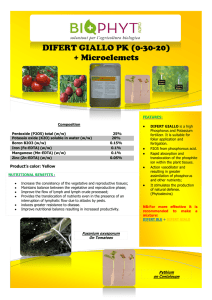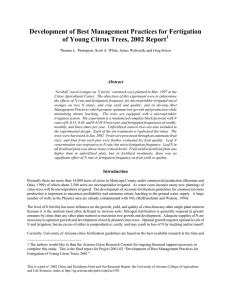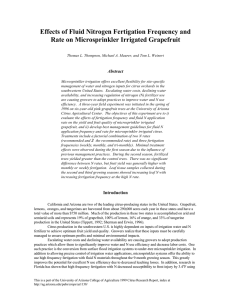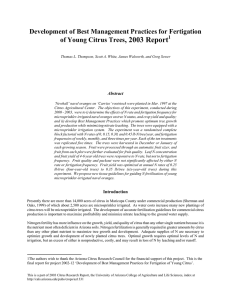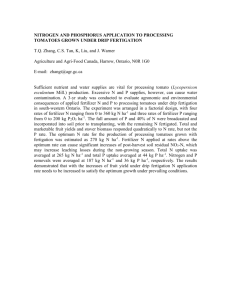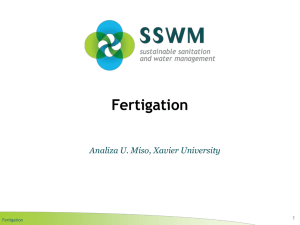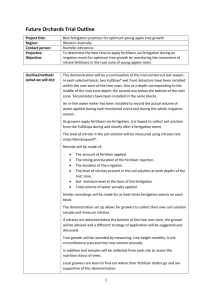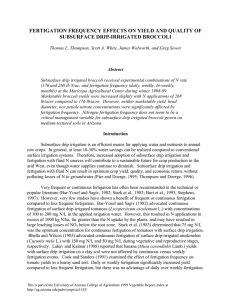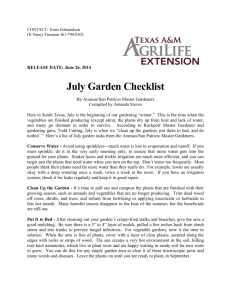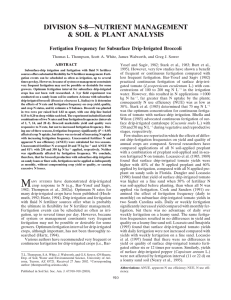Development of Best Management Practices for Fertigation of Young Citrus Trees 1 Abstract
advertisement
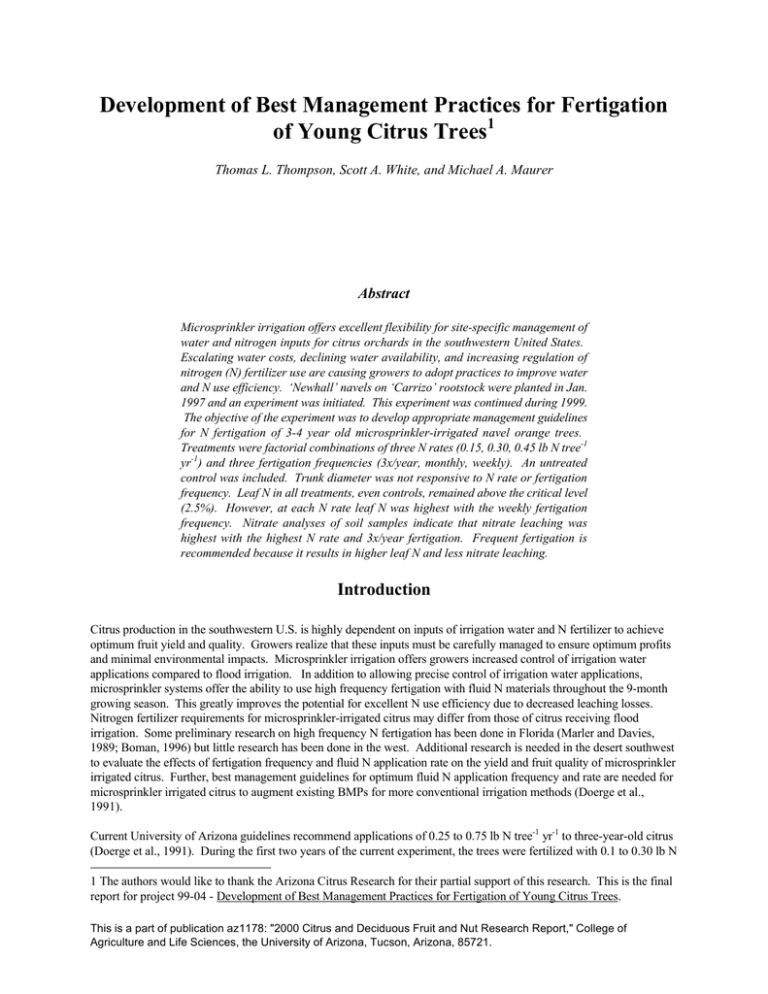
Development of Best Management Practices for Fertigation of Young Citrus Trees1 Thomas L. Thompson, Scott A. White, and Michael A. Maurer Abstract Microsprinkler irrigation offers excellent flexibility for site-specific management of water and nitrogen inputs for citrus orchards in the southwestern United States. Escalating water costs, declining water availability, and increasing regulation of nitrogen (N) fertilizer use are causing growers to adopt practices to improve water and N use efficiency. ‘Newhall’ navels on ‘Carrizo’ rootstock were planted in Jan. 1997 and an experiment was initiated. This experiment was continued during 1999. The objective of the experiment was to develop appropriate management guidelines for N fertigation of 3-4 year old microsprinkler-irrigated navel orange trees. Treatments were factorial combinations of three N rates (0.15, 0.30, 0.45 lb N tree-1 yr-1) and three fertigation frequencies (3x/year, monthly, weekly). An untreated control was included. Trunk diameter was not responsive to N rate or fertigation frequency. Leaf N in all treatments, even controls, remained above the critical level (2.5%). However, at each N rate leaf N was highest with the weekly fertigation frequency. Nitrate analyses of soil samples indicate that nitrate leaching was highest with the highest N rate and 3x/year fertigation. Frequent fertigation is recommended because it results in higher leaf N and less nitrate leaching. Introduction Citrus production in the southwestern U.S. is highly dependent on inputs of irrigation water and N fertilizer to achieve optimum fruit yield and quality. Growers realize that these inputs must be carefully managed to ensure optimum profits and minimal environmental impacts. Microsprinkler irrigation offers growers increased control of irrigation water applications compared to flood irrigation. In addition to allowing precise control of irrigation water applications, microsprinkler systems offer the ability to use high frequency fertigation with fluid N materials throughout the 9-month growing season. This greatly improves the potential for excellent N use efficiency due to decreased leaching losses. Nitrogen fertilizer requirements for microsprinkler-irrigated citrus may differ from those of citrus receiving flood irrigation. Some preliminary research on high frequency N fertigation has been done in Florida (Marler and Davies, 1989; Boman, 1996) but little research has been done in the west. Additional research is needed in the desert southwest to evaluate the effects of fertigation frequency and fluid N application rate on the yield and fruit quality of microsprinkler irrigated citrus. Further, best management guidelines for optimum fluid N application frequency and rate are needed for microsprinkler irrigated citrus to augment existing BMPs for more conventional irrigation methods (Doerge et al., 1991). Current University of Arizona guidelines recommend applications of 0.25 to 0.75 lb N tree-1 yr-1 to three-year-old citrus (Doerge et al., 1991). During the first two years of the current experiment, the trees were fertilized with 0.1 to 0.30 lb N 1 The authors would like to thank the Arizona Citrus Research for their partial support of this research. This is the final report for project 99-04 - Development of Best Management Practices for Fertigation of Young Citrus Trees. This is a part of publication az1178: "2000 Citrus and Deciduous Fruit and Nut Research Report," College of Agriculture and Life Sciences, the University of Arizona, Tucson, Arizona, 85721. tree-1 yr-1. Very little (<25%) of this N was taken up by the trees (Weinert, 2000). Therefore, N rates for young microsprinkler-irrigated trees may need to be reduced from current rates. The objective of this experiment was to develop appropriate management guidelines for N fertigation of 3-4 year old microsprinkler-irrigated navel orange trees. Materials and Methods Site Characteristics. Field studies were conducted during the 1999 growing season at the University of Arizona Citrus Agricultural Center in Waddell. The experiment is conducted on a Gilman loam. Chemical properties of the surface soil are pH 8.0, Ece 0.7 dS/m, extractable K 702 ppm, exchangeable sodium <1%, and CaCO3 <1%. A uniform block of ‘Newhall’ navel orange trees on ‘Carrizo’ rootstock was used for this experiment. The trees were planted in Jan. 1997. Cultural Practices. The trees are equipped with a microsprinkler irrigation system and plumbed to separately deliver the 9 N fertigation frequency x rate treatments listed in Table 1. The experimental design is a randomized complete block factorial with three N fertigation frequencies and three fluid N rates. There are 2 trees per plot and 5 replicate plots per treatment. Five replicate unfertilized control plots are also included in the experiment. Water and N are delivered through a microsprinkler irrigation system with all buried main lines and laterals and one 300o pattern microsprinkler per tree. The microsprinklers are placed on both sides of the trunk so that the spray pattern covers the entire area within the drip line and water-trunk contact is avoided. The N is supplied as urea-ammonium nitrate solution (UAN-32) and is injected into the appropriate fertigation lines using an in-line Dosatron injector. All trees are irrigated uniformly 2 to 3 times per week. Daily readings of tensiometers placed at 12, 18, and 24-inch depths are used to maintain soil moisture above about 1/3 available moisture depletion, which is the optimum level for bearing citrus trees. All other cultural practices are done in accordance with accepted commercial standards. Crop and Soil Measurements. Tree N nutritional status is monitored by late summer leaf tissue analysis (Doerge et al., 1991) in each year. Soil samples were taken in one-foot increments to depths of 4 feet at the beginning of the study (Jan. 1997) and at the end of the 1997, 1998, and 1999 growing seasons. The soil samples were analyzed for 1M KClextractable NH4 and NO3. Results and Discussion Trunk diameter during 1999 was not responsive to either N rate or fertigation frequency (data not shown). Leaf N in all treatments was above the critical level of 2.5% N, indicating that the trees were not deficient in N (Fig. 1). It is interesting that even the control trees, which had not received N fertilizer in the previous two-and-a-half years, were above the critical concentration. However, the trees receiving weekly fertigation had the highest leaf N at each N rate, suggesting that frequent fertigation increases fertilizer N availability to the trees. Soil samples analyzed for nitrate suggest important differences between treatments (Fig. 2). When N rate was <0.3 lb N tree-1 yr-1, little nitrate was leached. On the other hand, application of 0.45 lb N tree-1 appeared to result in substantial amounts of nitrate leaching. Similarly, nitrate leaching appeared to be minimal with weekly or monthly fertigation, and higher with fertigation only 3 times per year. Conclusions Navel orange tree growth (trunk diameter) was relatively unresponsive to ranges of N rates and fertigation frequencies. Leaf N remained above critical levels in all treatments, and was increased by weekly fertigation, compared to monthly or 3x yearly fertigation. Nitrate leaching was apparently highest at the highest N rate and with low fertigation frequency. These results suggest, as did previous research, that N rates for young microsprinkler-irrigated navel oranges can be reduced significantly from currently recommended rates. This experiment should be continued until trees are bearing fruit to fully determine the effects of these treatments. Literature Cited 1. Boman, B.J. 1996. Fertigation enhances grapefruit yield. Fluid Journal, Fall 1996, p. 10-13. 2. Doerge, T.A., R.L. Roth, and B.R. Gardner. 1991. Nitrogen fertilizer management in Arizona. University of Arizona, College of Agriculture, No. 191025. 3. Marler, T.E. and F.S. Davies. 1989. Microsprinkler irrigation scheduling and pattern effects on growth of young ‘Hamlin’ orange trees. Proc. Fla. State Hort. Soc. 102:57-60. 4. Weinert, T.A. 2000. Optimizing nitrogen management for microsprinkler-irrigated citrus in central Arizona. Ph.D. Dissertation. University of Arizona. Table 1. Fertigation frequency and N fertilizer application rate treatments for the 1999 growing season. Treatment N Fertigation Frequency Fertigation Events per Season Cumulative N Rate lb/tree 1 3X/year 3 0.15 2 Monthly 9 0.15 3 Weekly 36 0.15 4 3X/year 3 0.3 5 Monthly 9 0.3 6 Weekly 36 0.3 7 3X/year 3 0.45 8 Monthly 9 0.45 9 Weekly 36 0.45 10 None 0 0

